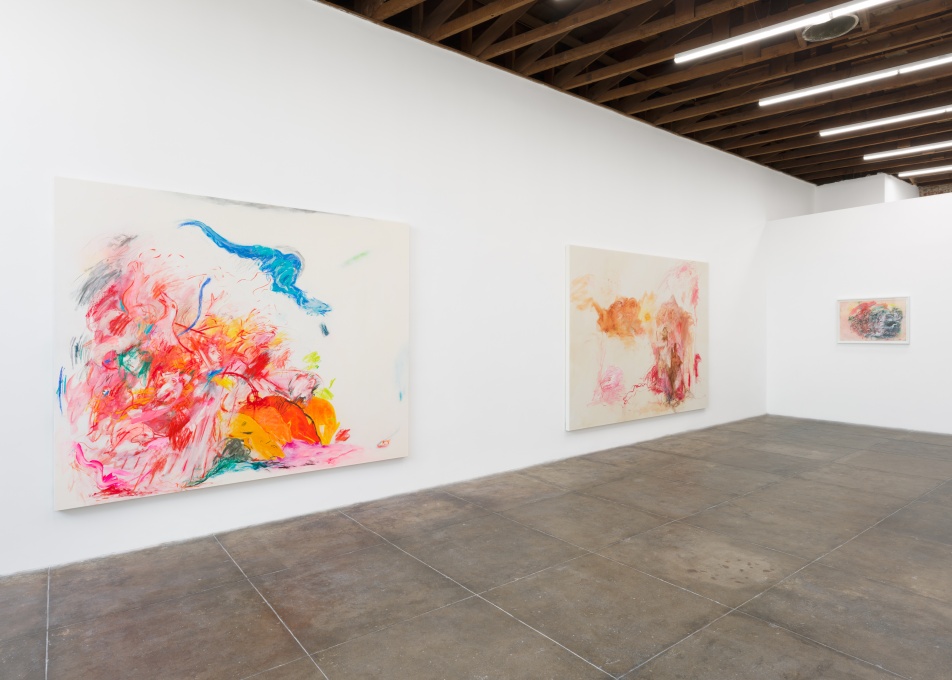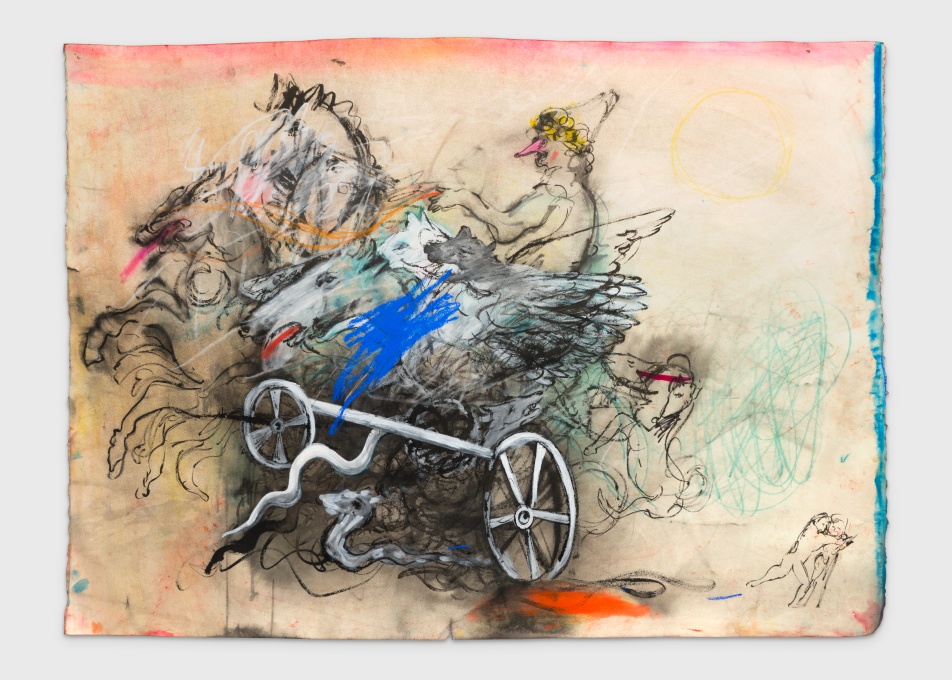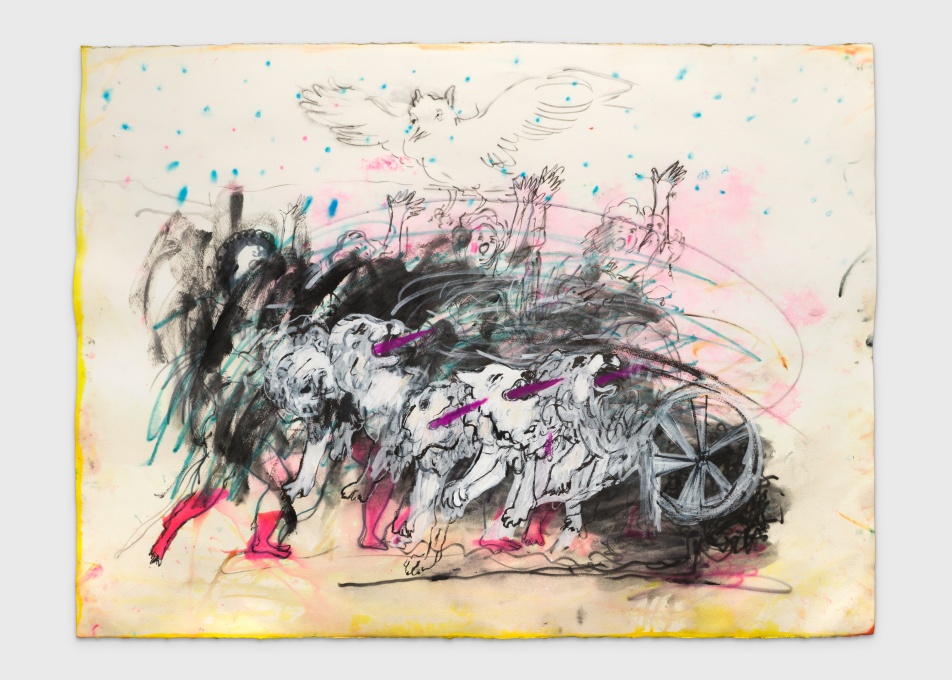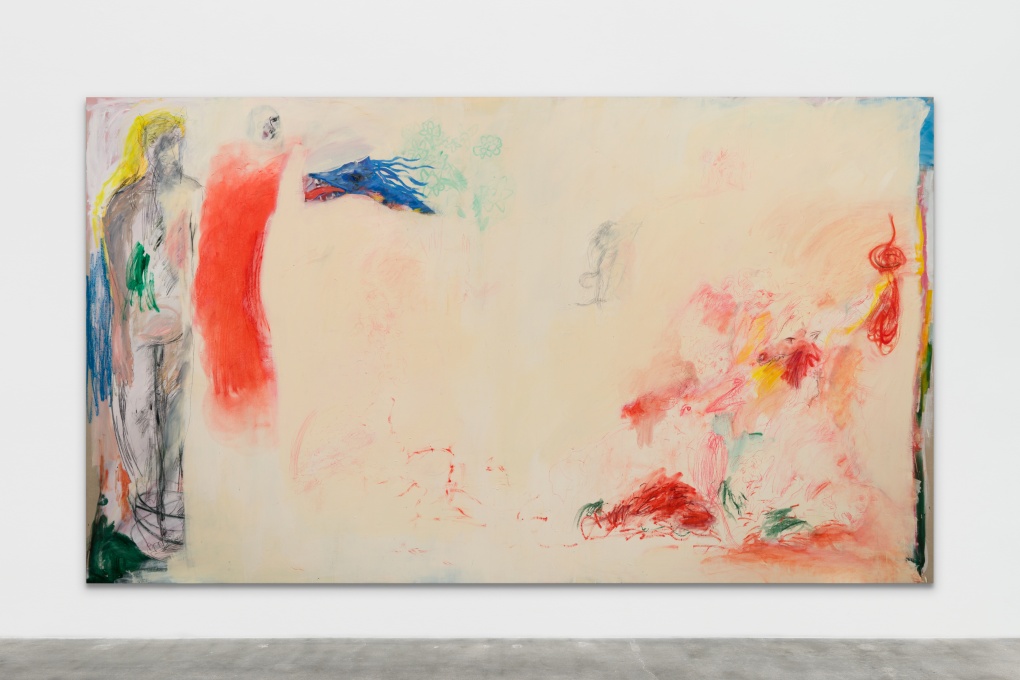Artists at Work: Sara Issakharian
by Sóla Saar Agustsson

Sara Issakharian, Homeward Bound, 2021. Acrylic, pastel, and charcoal on paper. 200.6×281.9 cm. Photo: Dan Finlayson. Courtesy of the artist and Tanya Leighton, Berlin.
Sara Issakharian is a mixed-media painter based between Los Angeles and Berlin. After studying philosophy and social science at UCLA, Issakharian received her MFA in Painting at the New York Academy of Art. Born and raised in Tehran, her work takes up themes such as the grief of emigration, women’s oppression, and state violence. Her first solo exhibition in Los Angeles, ‘There’s a whole life in that, in knowing that the sun is there,‘ which opened at Tanya Leighton Gallery in August 2021, explores the duality of light and darkness. Issakharian’s work has been featured internationally at Art Basel, Miami Beach and Art Basel, Switzerland, and has traveled to India, Iran, and Lebanon. Her work will be included in an upcoming group exhibition, “Abstract Now,” at SITE131 in Dallas, Texas.
Sóla Saar Agustsson: The title of your recent solo exhibition at Tanya Leighton is a Dostoevsky quote from The Brothers Karamazov—“There’s a whole life in that, in knowing that the sun is there.” Can you talk about the significance of that in relation to your work?
Sara Issakharian: Well, I love Dostoevsky and I’m always influenced by his literature, and this is one of my favorite quotes. The influence this takes in the works is mostly related to the social status of women in Iran and what they’re going through. They live an ordinary life, like us. But in terms of having rights, they basically don’t have any rights. When it comes to getting divorced, or leaving the country, or taking care of their kids, they have to get permits from their husbands or their fathers to be able to do any of those things. I grew up in that kind of society, witnessing women still being so happy and powerful and courageous, still celebrating life to the utmost. This contradiction, celebrating life despite all of the difficulty that society puts in your way, is magic. That’s the reason for the title of the series. It’s more realistic than pessimistic or optimistic, I think.

Installation view of ‘There’s a whole life in that, knowing that the sun is there’, 2021. Photo: Dan Finlayson. Courtesy of the artist and Tanya Leighton, Berlin.
SSA: I’m interested in the way you use light and color because it’s kind of similar to that philosophy. In terms of your painting technique, how does light work for you?
SI: Honestly, I started painting with very dark colors, mainly black, and I loved monochrome until I went to Berlin and faced the winter there. The sky was completely gray and it was heartbreaking each time I would come to the studio and face my canvas—working with dark tones was too much. I needed some light, so I brought light into the paintings. I started playing with red a little bit. Also, I think you need to give the viewer space to play with an idea. You can’t just hand everything over on the canvas and say, here, it’s a black painting and it’s about the dark—violence and repression and all that. You have to create something that lets space in. I thought those black paintings at the time weren’t allowing that, but maybe in this light people are able to look through and find their own stories, or see what the painting wants to reveal.
SSA: Do you think being in L.A. has influenced that?
SI: Yeah, it’s funny because I just started working in L.A. and the first painting I made, it’s black again, probably because I see so much sun outside. I’m back to my dark, but not as dark! But I think the sun and the natural light of a place always matters.
SSA: I could see wanting to capture a certain darkness and anger. I noticed in works, like Pleasure and Inside the Frame, the mood is a little aggressive and war-like…
SI: Painting is its own entity, and there are times that it requires aggression. I think you might start with a certain idea, but once you start painting, the painting itself tells you what you’ve got to do on the canvas. And sometimes it requires something softer, sometimes it’s more aggressive. The idea is what initiates the work, but somehow in the process it gets lost and the painting takes over.

Sara Issakharian, Pleasure, 2021. Acrylic, ink, colour pencil, and pastel on paper. 55.9×76.2 cm. Photo: Dan Finlayson. Courtesy of the artist and Tanya Leighton, Berlin.
SSA: Materially your paintings are very layered—they have colored pencil and charcoal, too. Where did you learn that technique, or what made you want to bring in those other materials?
SI: I’m very drawn to the idea of innocence, and colored pencils and charcoal have a kind of innocence that I enjoy. I love how when a child draws they grip the pencil so hard in their hand, as if it’s very important.
I didn’t learn much about technique until I went to the Academy, but even there the main focus was oil. Usually the pencil goes on last in my work because I delete a lot—I do ten paintings under one painting and on the last surface I like to play with colored pencils and just doodle the way a child doodles. I think brushes have a heavier energy. When you get a brush in your hand, somehow there’s all this technicality that comes with it. You think about brush strokes and how thick and how thin, but colored pencil is way more simple. It’s very innocent and egoless and delicate. Charcoal lets me do that, too.
SSA: The press release for your recent show in L.A. says that you drew from styles of early modernists who were nationalists and wanted to return to what they considered “primitive” societies, which is a very imperialistic concept. But you’re reframing it as a woman of color, in a different way. Can you talk about that?
SI: I think there is some influence from Goya, Bellini, Fra Angelico, Rubens—those kinds of very complicated, messy compositions—people, armies, war. I am mostly affected by those. There’s also a tradition of miniature paintings in Iran that I grew up with. The main purpose of miniature paintings is to depict stories, and they are usually filled with depictions of humans and animals. Their surfaces are very flat. Primitive? I’m not sure. But I like to make very complicated compositions more simple and more childlike. I don’t like too much ego in art, so I tend to look for a kind of naïvete.

Sara Issakharian, Inside the Frame, 2021. Acrylic, ink, and colour pencil on paper. 55.9×76.2 cm. Photo: Dan Finlayson. Courtesy of the artist and Tanya Leighton, Berlin.
SSA: Your works have a sort of world-building to them—there are figures of mythical-like creatures. Are those based on any particular mythology, or did you create your own?
SI: No, I don’t think I created anything. In terms of imagery, I look at lots of ancient Egyptian and Indian sculptures. And I read a lot about Greek mythology and I took from what has existed. My recent works are very much based on the story of Pandora’s box. Also, in Iran, most of the stories you grow up with are based on myth and demons. I use a lot of dragons, serpents, and lions because there’s a violence associated with each one of them. But they come with knowledge and wisdom too, so it’s double-sided. If you dream of a serpent it’s a negative sign, but it also symbolizes a lot of money and power and everything. So I like to show the duality of things, the light and the dark, the power and the violence, because they all exist together. They walk alongside each other, like the moon and the sun.
I think growing up in a society like Iran, in every moment you could feel the extremes. You could be having so much fun at a party and then suddenly the guards would come… I think every happiness was experienced with a bit of pain. So maybe that’s why I experienced life with this duality. Then later, growing up and getting more into philosophy, I realized that’s just the nature of life—there’s always another side to it. Sometimes the moon is out, sometimes the sun is out, sometimes the light is more visible and sometimes it’s the other way around.
SSA: The metaphor of the sun in the moon is very “it is what it is.” I also noticed that a lot of your titles, Homeward Bound and Remembered Landscape, speak to emigration and grieving.
SI: Emigration is always hard because you really lose some roots. You have to start all over, especially if you go from a Middle Eastern country to a Western country because they have pretty much nothing in common. If you land in New York or L.A., you’re lucky because you can find your community more easily. But still, because language is so important to how we perceive things, suddenly when our language changes many of our beliefs start to crash along with it. Adapting to a new environment is very difficult, so that’s where all the nostalgia comes in. Whatever you can remember from the past becomes bigger, brighter, nicer. In L.A. we live by the ocean, but when I want to talk about my best memories I talk about the sea in Iran, even though the ocean in L.A. is one hundred times sunnier, but it’s the nostalgia that makes more of an impression. Also, when you leave your country and you have to leave—it’s not like you do it by choice—you lose your base, and then you sort of look for it everywhere for a long time. Maybe I just like to go back and look at that base again and again and again, to remember that once I had a place I called home.

Sara Issakharian, detail of Homeward Bound, 2021. Photo: Dan Finlayson. Courtesy of the artist and Tanya Leighton, Berlin.
SSA: When did you start practicing art?
SI: I was always making art as a kid growing up, but never professionally, never in a class. I remember when Iran was at war with the Iraqis, parents would have their children play underneath the tables to be safe. I don’t know how well a wooden table could really protect us from bombs, but that was a place for all of us to draw and paint and make paper sculptures.
When I finished my bachelor’s degree, I went back to Iran and stayed there for a few years. This was around the time of one of the presidential elections. Unfortunately, things got very bad and people came to streets to protest against the election. Among those protestors were many of my artist friends. They used to protest on the streets of Tehran and after we would gather at a small house where we discussed everything going on, and we drew. We would draw and talk about all of the issues of inequality and injustice and, of course, life. It became like a family for all of us, and sort of like therapy. I spent quite a long time with these friends and those drawings later went into my application for art school.
SSA: How do you think not being formally trained in painting influenced your art school experience?
SI: The beginning was difficult. We had to paint from live models every day and painting flesh from a live model is not easy. But you learn and it takes time and the friends you make in art school really are the best teachers. However, later on, I think not being formally trained helped me because it allowed for more genuineness and more rawness. It let the work be more playful. I enjoy the dialogue of opposite poles in general and to be able to depict that is a plus for me. I was always looking at compositions of the masters too and I thought composition always mattered, but not being so knowledgeable about formal ways of painting let me, in the end, feel more of a freedom.

Sara Issakharian, Remembered Landscape, 2021. Acrylic, pastel, and charcoal on paper. 200.6×281.9 cm. Photo: Dan Finlayson. Courtesy of the artist and Tanya Leighton, Berlin.
SSA: What’s your studio schedule like? Do you paint every morning?
SI: Yeah, my studio is at the Santa Monica airport. I come in every morning, around 10:00 a.m., but I’m a night person and work mostly at night. I love the silence of the night and it’s the best time for me to work, so I usually stay until midnight or later.
SSA: Has the quarantine affected you at all?
SI: Quarantine was interesting because I went to a residency in Berlin and was hoping to visit a lot of museums there, but I landed and of course everything was closed. I just had my studio, so I worked a lot because there was nothing to do. I used to walk by the river every day and see a lot of swans—that’s why swans came into my paintings. I think basically my studio schedule stayed the same as before, but it’s difficult when you see everybody going through difficult times. I worked more than ever, but it’s just not so revealing to be in your studio alone and doing your own thing all the time.
SSA: You said you’re doing darker paintings now. Do you think that’s related?
SI: I’m painting with darker tones, but it is what it is. I don’t want to necessarily say this is a dark painting, or this is a light painting. It’s always a mixture of things, so I like to show the range and hope I don’t get stuck with only one format. That would not be ideal for what I want to express.

Sara Issakharian, detail of Remembered Landscapes, 2021. Photo: Dan Finlayson. Courtesy of the artist and Tanya Leighton, Berlin.
SSA: Do you see yourself working within mediums other than painting? How do you approach trying new formats?
SI: I love film and at times I edit some short videos. I also love sculpture and I do a lot of sketches for sculpture, but I have zero training and no idea how to make a sculpture. I’m planning to work with some sculpting studios after I come back from Basel, just to learn with them. I’ve always been really taken by theater and stage design, too. For now painting is what wants to come out, so I let it out. I like to play and experiment though, and sometimes painting can be limited. Maybe sculpture or film could say more.
I’ve been thinking about sculptures for a long time now and have some ideas to work with large pieces of foam. I also like to work with found objects. Any object that you see lying around has a history and creating a story with that history and putting it in dialogue is really fascinating to me.
SSA: You have a show in 2023 at Tanya Leighton in Berlin. Is there anything else you’re working on now?
SI: I’ll be part of a group show in Dallas at SITE131, and another group show at Andrew Kreps in New York. I’m preparing for those until Berlin.
SSA: Is there anything else you want to add?
SI: It’s not so much about me. As the artist, you always have stories and perceptions you bring to the work, but I think the beautiful thing about painting is its capacity to allow the viewer to think whatever, to see whatever. I hope my art does that.
